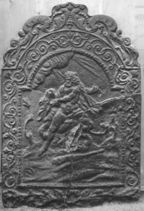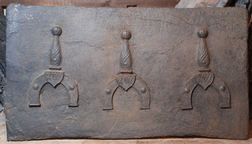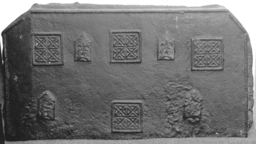-
155
Description: Arched rectangular shaped central panel with paternost bead edging; Hercules/Herakles slaying the Nemean lion on a ground with small trees, his club lying at his feet; above, clouds and sun rays; arched rectangular shaped border with fillet edging, symmetrical arrangement of swirled tendrils, floral wreath at base; on top, symmetrical arrangement of foliage.
Notes: The image is taken from an engraving by Gerard de Jode, from his series 'The Labours of Hercules', after Marcus Geeraerts, 1519 - 1591. One of many English firebacks which copied 'Dutch' styles. Formerly part of the Ade Collection (from Grove Hill, Hellingly, Sussex).
Copies of this fireback are known.
- Decoration tags:
- 'Dutch' (shape)
- fillet (edging)
- whole carved pattern
- pictorial
- mythological
- humans
Manufactured: in the early-18th century in England.
Current location: Hastings Museum and Art Gallery, John's Place, Bohemia Road, Hastings, East Sussex, England.
Museum number: HASMG: 1952.51.27 (part of the Hastings Museum museum group)
- Attached to series:
- British 'Dutch' style firebacks
-
160
Description: Arched rectangular shaped panel with fillet edging; two Salomonic columns supporting a beaded arch; standing figure of Atlas supporting a globe, on ground with plants, and two swags of fruit and leaves suspended from the centre of the arch to the capitals of the columns; above the beaded arch, symmetrical swirls of fruit and foliage; on top, a scallop shell between two sea serpents.
Notes: Probably an English design copying the north German 'Dutch' style.
Copies of this fireback are known.
- Decoration tags:
- 'Dutch' (shape)
- fillet (edging)
- whole carved pattern
- mythological
- architectural
- humans
- plants
- objects
Manufactured: in the late-17th to early-18th century in England.
Current location: Hastings Museum and Art Gallery, John's Place, Bohemia Road, Hastings, East Sussex, England.
Museum number: HASMG: 1917.196.6 (part of the Hastings Museum museum group)
Citation: Butterfield, W. R., 1916, 'Old Wealden Firebacks', The Connoisseur, 46, pp. 197-209.
Citation: Lloyd, N., 1925, 'Domestic Ironwork I', Architectural Review, 58, pp. 58-67.
Citation: Baines, J. M., 1958, Wealden Firebacks (Hastings Museum).
- Attached to series:
- British 'Dutch' style firebacks
-
163
Description: Arched rectangular shape with fillet edging; tall, arched central panel with bead edging (top and sides); flying bird in arch, with two small trees below, and two figures, one with a staff in his right hand, and a dog, at the bottom; two side panels with similar cascades of flowers; narrow base panel with fillet edging and symmetrical floral arrangement; on top, a scallop shell between two symmetrical lines of trailing flowers.
Notes: The figures may be Venus and Adonis, the bird aboive being a dove; probably an English design based on the 'Dutch' style. Formerly part of the Ade Collection (from Grove Hill, Hellingly, Sussex).
Manufactured: in the late-17th to early-18th century in England.
Current location: Hastings Museum and Art Gallery, John's Place, Bohemia Road, Hastings, East Sussex, England.
Museum number: HASMG: 1952.51.31 (part of the Hastings Museum museum group)
- Attached to series:
- British 'Dutch' style firebacks
-
165
Description: Rectangular with low, 3-facetted arch; ovolo edging; shield of the Goldsmiths’ Company: quarterly Gules and Azure, in the first and fourth quarters a Leopard's Head affrontée Or, in the second and third quarters a Covered Cup between in chief two Buckles fesswise all of the last; behind the shield is a scrolled escutcheon.
Notes: An unusually thick fireback. The Goldsmiths’ Company were granted arms in 1571.
Copies of this fireback are known.
Arms: Worshipful Company of Goldsmiths
- Decoration tags:
- rectangular with three-facetted arch (shape)
- ovolo (edging)
- whole carved pattern
- armorial
Manufactured: in the late-16th to early-17th century possibly in the Weald area of England.
Current location: Hastings Museum and Art Gallery, John's Place, Bohemia Road, Hastings, East Sussex, England.
Museum number: HASMG: 1978.15 (part of the Hastings Museum museum group)
- Attached to series:
- Livery company firebacks
-
166
Description: Rectangular; plain plate with three stamps of an iron firedog with a twisted design on the neck, a primitive face on the terminal and a shield bearing initials RW.
Notes: The letters RW are said to relate to Richard Woodman, ironmaster and Protestant martyr, who resided at Cralle Place, and who operated Cralle furnace. A near-identical firedog was discovered at Bridge Cottage, Uckfield, Sussex.
Inscription: RW
- Decoration tags:
- rectangular (shape)
- none (edging)
- simple stamps
- objects
Manufactured: in the mid-16th century probably at Cralle Furnace, Warbleton in the Weald area of England.
Current location: Hastings Museum and Art Gallery, John's Place, Bohemia Road, Hastings, East Sussex, England.
Museum number: HASMG: 1909.94 (part of the Hastings Museum museum group)
Citation: Butterfield, W. R., 1916, 'Old Wealden Firebacks', The Connoisseur, 46, pp. 197-209.
- Attached to series:
- Firedog stamp firebacks
- Metalware stamp firebacks
-
168
Description: Quasi-arched shape; straight fillet edging to sides and bottom, symmetrical, stepped cavetto, ovolo, cavetto and double arched on top; central pictorial scene of a female and male seated on a couch, both in 18th century dress, with swirled floral border; swirled floral base panel separated by a fillet; two sea serpents on top.
Notes: The dress of the figures portrayed suggests a late-18th century date
- Decoration tags:
- rectangular with ornate arch (shape)
- fillet (edging)
- whole carved pattern
- pictorial
- humans
- objects
Manufactured: in the late-18th century in England.
Current location: Hastings Museum and Art Gallery, John's Place, Bohemia Road, Hastings, East Sussex, England.
Museum number: HASMG: 1910.36 (part of the Hastings Museum museum group)
- Attached to series:
- Miscellaneous pattern firebacks
-
170
Description: Canted rectangle; twisted rope edging (top and sides); square stamp with fillet edge and four diagonally quartered squares, repeated three times along top and once centre bottom; square stamp with triangular top containing intaglio fleur de lys, two positioned between squares in top row, and two separated by square below. Formerly part of the Ade Collection (from Grove Hill, Hellingly, Sussex).
Notes: The smaller stamp could also be interpreted as a face in caricature with a pointed hat, perhaps a bishop's mitre. It appears that more iron was poured into the mould than its depth allowed for, resulting in the considerable thickness of the casting.
- Decoration tags:
- rectangular with canted top corners (shape)
- rope (edging)
- carved stamps
Manufactured: in the mid- to late-16th century possibly in the Weald area of England.
Current location: Hastings Museum and Art Gallery, John's Place, Bohemia Road, Hastings, East Sussex, England.
Museum number: HASMG: 1952.51.22 (part of the Hastings Museum museum group)
- Attached to series:
- Food mould stamp firebacks
- Crossed square Wealden series
-
169
Description: Rectangular; twisted rope edging (top and sides); inscription made of short lengths of twisted rope, irregularly spaced across upper middle, central device formed of a Tudor 'A' with overstamped 'V'.
Notes: It is not clear if the central device is a monogram, or if it might have apotropaic significance.
Inscription: T A M T
- Decoration tags:
- rectangular (shape)
- rope (edging)
- simple stamps
- apotropaic
- text
- objects
Manufactured: in the early- to mid-16th century in the Weald area of England.
Current location: Hastings Museum and Art Gallery, John's Place, Bohemia Road, Hastings, East Sussex, England.
Museum number: HASMG: 1911.60.7 (part of the Hastings Museum museum group)
Citation: Page, S. & Wallace, M. (eds.), 2018, Spellbound (Oxford, Ashmolean Museum), p. 72.
- Attached to series:
- Rope design firebacks
-
171
Description: Quasi-rectangular with raised symmetrical scrolls between semi-circular re-entrants on top edge; ovolo-moulded edge on bottom and sides, with fillet edging on top; grotesque face with swirled hair locks, above an inverted floral spike, between two moustachioed male figures in tunics, holding pikes, standing on a cavetto-moulded compartment, date beneath.
Notes: Alleged to represent the 'Brede Ogre', Sir Goddard Oxenbridge (1478-1531) who, legend states, was sawn in half by local children. Stylistically similar to other firebacks with connections with Brede furnace.
Copies of this fireback are known.
Inscription: 16 52
- Decoration tags:
- rectangular with ornate arch (shape)
- fillet (edging)
- whole carved pattern
- individual numbers
- pictorial
- text
- humans
Manufactured: in 1652 probably at Brede Furnace in the Weald area of England.
Current location: Hastings Museum and Art Gallery, John's Place, Bohemia Road, Hastings, East Sussex, England.
Museum number: HASMG: 1924.42 (part of the Hastings Museum museum group)
Citation: Baines, J. M., 1958, Wealden Firebacks (Hastings Museum).
Citation: Butterfield, W. R., 10 Mar 1934, 'The Brede Ogre', Hastings and St Leonards Observer.
- Attached to series:
- Hooked '1' series
- Brede group
-
173
Description: Rectangular; twisted rope edging (top, and top two-thirds of sides); rectangular stamp with griffin passant, repeated six times: two in top corners; two in bottom corners, rotated left; two in middle, separated by two inverted shields bearing a rose and crown, placed vertically; across each top corner, a length of twisted rope.
Notes: Five other firebacks bearing these stamps are known: one is also in Hastings, and one, dated 1569, is at Hadlow Down, Sussex. The locations of the other three are not known.
- Decoration tags:
- rectangular (shape)
- rope (edging)
- simple stamps
- carved stamps
- heraldic
- objects
Manufactured: in the mid- to late-16th century in the Weald area of England.
Current location: Hastings Museum and Art Gallery, John's Place, Bohemia Road, Hastings, East Sussex, England.
Museum number: HASMG: 1909.78 (part of the Hastings Museum museum group)
Citation: Baines, J. M., 1958, Wealden Firebacks (Hastings Museum).
- Attached to series:
- Griffin series









